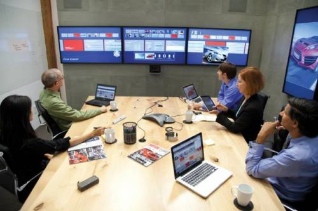Are business center owners and operators ready to take on Hollywood action film technology?
A recent article from phys.org turns the spotlight on ‘gesture-control technology’, used in movies such as Iron Man, and now being deployed in Fortune 500 conference rooms throughout the world.
The inventor of the technology, MIT alumnus John Underkoffler, has brought the new platform known as ‘G Speak’ to the business world in the form of a collaborative conference environment called Mezzanine.
We’ve reprinted the full article below, written by Rob Matheson for phys.org, so that you can learn, first hand, how gesture-control works and is being deployed.
As this technology becomes perfected and usage increases, it may only be a matter of time before savvy business center owners and operators begin deploying similar solutions within their meeting room spaces to raise their brands to a new level of sophistication in meeting interaction and collaboration.
———————————————
Bringing gesture-control technology from Hollywood to corporate conference rooms
Sep 08, 2014 by Rob Matheson
Image: Oblong’s collaborative-conferencing system, Mezzanine, being used in a conference room. Credit: Oblong Industries
When you imagine the future of gesture-control interfaces, you might think of the popular science-fiction films “Minority Report” (2002) or “Iron Man” (2008). In those films, the protagonists use their hands or wireless gloves to seamlessly scroll through and manipulate visual data on a wall-sized, panoramic screen.
We’re not quite there yet. But the brain behind those Hollywood interfaces, MIT alumnus John Underkoffler ’88, SM ’91, PhD ’99—who served as scientific advisor for both films—has been bringing a more practical version of that technology to conference rooms of Fortune 500 and other companies for the past year.
Underkoffler’s company, Oblong Industries, has developed a platform called g-speak, based on MIT research, and a collaborative-conferencing system called Mezzanine that allows multiple users to simultaneously share and control digital content across multiple screens, from any device, using gesture control.
Overall, the major benefit in such a system lies in boosting productivity during meetings, says Underkoffler, Oblong’s CEO. This is especially true for clients who tend to pool resources into brainstorming and whose meeting rooms may remain open all day, every day.
“If you can make those meetings synthetically productive—not just times for people to check in, produce status reports, or check email surreptitiously under the table—that can be an electrifying force for the enterprise,” he says.
Mezzanine surrounds a conference room with multiple screens, as well as the “brains” of the system (a small server) that controls and syncs everything. Several Wii-like wands, with six degrees of freedom, allow users to manipulate content—such as text, photos, videos, maps, charts, spreadsheets, and PDFs—depending on certain gestures they make with the wand.
That system is built on g-speak, a type of operating system—or a so-called “spatial operating environment”—used by developers to create their own programs that run like Mezzanine.
“G-speak programs run in a distributed way across multiple machines and allow concurrent interactions for multiple people,” Underkoffler says. “This shift in thinking—as if from single sequential notes to chords and harmonies—is powerful.”
Oblong’s clients include Boeing, Saudi Aramco, SAP, General Electric, and IBM, as well as government agencies and academic institutions, such as Harvard University’s Graduate School of Design. Architects and real estate firms are also using the system for structural designing.


 Dr. Gleb Tsipursky – The Office Whisperer
Dr. Gleb Tsipursky – The Office Whisperer Nirit Cohen – WorkFutures
Nirit Cohen – WorkFutures Angela Howard – Culture Expert
Angela Howard – Culture Expert Drew Jones – Design & Innovation
Drew Jones – Design & Innovation Jonathan Price – CRE & Flex Expert
Jonathan Price – CRE & Flex Expert













